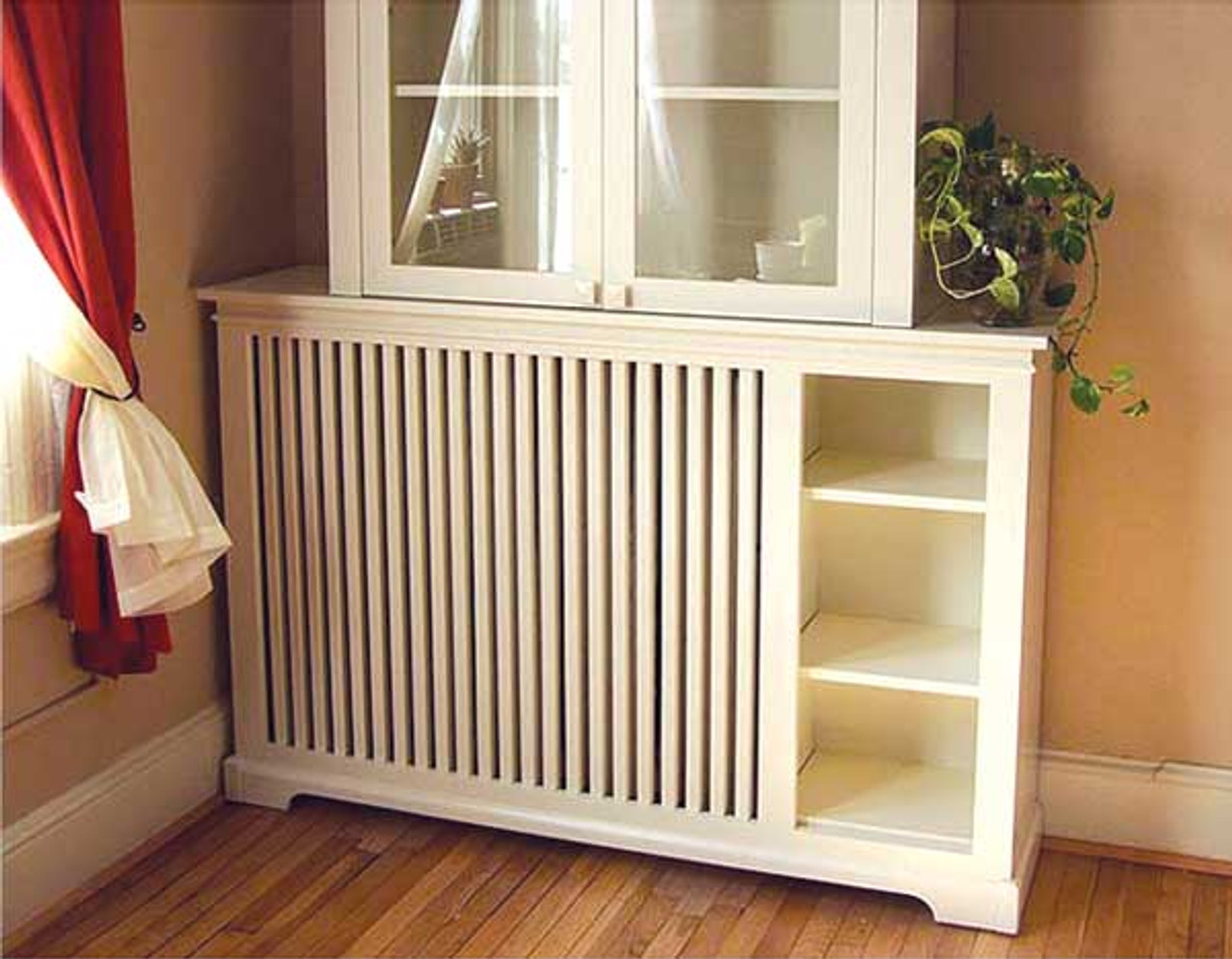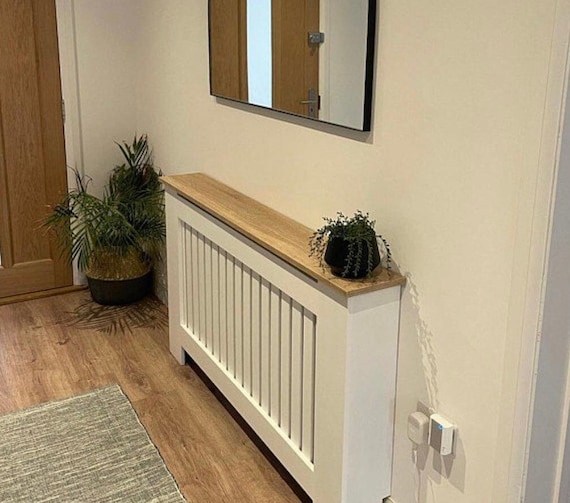What Most People Get Wrong About Custom Radiator Covers (And How to Fix It)
What Most People Get Wrong About Custom Radiator Covers (And How to Fix It)
Blog Article
Trick Functions to Consider When Selecting Custom Radiator Covers for Your Room
Picking custom-made radiator covers involves several important variables. Product resilience is crucial for long life, while layout needs to balance with the existing decoration. Size fit is vital for performance and aesthetic appeals. In addition, considerations around warm efficiency and air movement can affect efficiency. The nuances of installment and maintenance often remain neglected. Understanding these aspects will assist you toward an educated choice that enhances your space easily. What other elements should be taken right into account?

Product Options for Personalized Radiator Covers
When picking customized radiator covers, the option of materials plays an important function in both aesthetic appeals and performance. Numerous products are available, each with one-of-a-kind buildings that satisfy different requirements. Timber, for circumstances, offers a traditional look and can be conveniently customized, yet it may be susceptible to contorting in high humidity. Steel alternatives, such as aluminum or steel, give longevity and warmth resistance, making them suitable for high-heat environments. custom radiator covers.For those seeking a modern-day touch, MDF (medium-density fiber board) is a popular choice; it can be repainted or ended up to match any kind of style while remaining economical. Furthermore, some might choose for acrylic, which permits imaginative designs and transparency, although it may not be as heat-resistant. Eventually, the choice of material considerably impacts not only the cover's appearance but likewise its long life and performance in effectively handling warm result
Layout Designs to Match Your Home Decor
Although radiator covers offer a practical purpose, their layout can substantially improve the general visual of a room. Homeowners can pick from different styles to perfectly integrate these covers right into their existing decoration. For a modern look, sleek steel or minimalist wood styles use a clean, modern ambiance. In comparison, conventional homes might gain from luxuriant wood covers with complex makings that reflect classic craftsmanship.Farmhouse styles typically incorporate rustic components, making use of reclaimed wood for a cozy, welcoming touch. For those who like an eclectic strategy, strong shades and patterns can be used to create a statement piece that attracts the eye.Additionally, incorporating decorative grilles or open layouts can permit airflow while including visual interest. Picking a layout that matches the total style of the home guarantees that the radiator cover comes to be not just a functional aspect yet also a trendy centerpiece within the area.
Dimension and Fit Factors To Consider
Exactly how can homeowners assure their customized radiator covers fit perfectly within their rooms? Precise measurements are important for achieving a smooth fit. Homeowners must begin by measuring the length, size, and height of their radiators, thinking about any type of extending elements such as pipelines or valves. In addition, it is crucial to take into consideration the surrounding space, ensuring that the cover does not obstruct air flow or hinder furniture placement.Choosing the appropriate product and style can also affect fit; as an example, some materials may need details thicknesses to assure durability. Property owners ought to also think of the intended design of the area, making sure that the cover enhances existing decoration while suitable comfortably in the designated area. A well-measured and attentively designed cover not only enhances visual appeals however also guarantees efficient heating by allowing correct ventilation around the radiator.
Setup Process and Demands
To ensure an effective installation of personalized radiator covers, mindful preparation and focus to information are essential. First, one must precisely measure the radiator dimensions and surrounding space to confirm a proper fit. Next off, choosing the best materials is necessary; alternatives might consist of wood, metal, or composite products, each needing certain tools and techniques for installation.Before beginning the installation, it is a good idea to gather all essential devices, such as braces, drills, and screwdrivers, to improve the procedure. The installation location should be free from barriers for security and efficiency.Once ready, the personalized covers can be safely mounted, ensuring that they are leveled and aligned properly. Adhering to producer standards throughout this stage is crucial to stay clear of any type of structural problems. A detailed evaluation must be performed to confirm that the covers are firmly attached and visually enticing, contributing to the overall visual of the room.
Warmth Efficiency and Airflow
When selecting custom radiator covers, heat efficiency and airflow are critical variables to contemplate. Proper ventilation layout guarantees suitable heat distribution throughout a space, protecting against cold places and taking full advantage of comfort. Focus to these elements can greatly enhance the general performance of a home heating system.
Optimum Warmth Distribution
Ideal warmth circulation is essential for maintaining a comfortable indoor atmosphere, and custom-made radiator covers can considerably enhance this process. custom radiator covers. These covers are made not only for appearances yet likewise to maximize warm effectiveness. By directing cozy air efficiently throughout the space, they protect against chilly spots and ensure that heat flows evenly. Properly developed covers can help with air flow while minimizing blockage, permitting cozy air to increase and disperse normally. Additionally, the products utilized in custom-made radiator covers can affect warm retention and output. Picking covers that stabilize style and functionality is important, as they can contribute markedly to a home's general heating efficiency, enhancing convenience and potentially reducing energy expenses in the long run
Air Flow Design Factors To Consider
Reliable ventilation layout is important for making certain suitable warm performance and air flow precede with radiator covers. When picking a personalized cover, it is important to consider functions that assist in unhampered air activity. Grilles and vents should be purposefully positioned to enable warm air to distribute openly while preventing getting too hot. Additionally, the material of the cover can influence air movement; lightweight products commonly promote much better ventilation contrasted to larger alternatives. The layout needs to likewise account for preserving suitable distances between the cover and radiator to boost effectiveness. Eventually, a properly designed radiator cover will certainly not just boost the visual appeal of a space but additionally contribute to efficient heating, creating a more comfortable setting.
Personalization and Customization Functions

Maintenance and Care Tips for Durability
Preserving custom-made radiator covers is necessary for their durability and look. Normal cleaning practices, making use of ideal cleaning remedies, and seasonal inspections can substantially enhance their longevity. Carrying out these treatment ideas guarantees that the covers continue to be practical and visually appealing over time.
Normal Dusting Practices
Consistently dusting custom-made radiator covers is important for maintaining their look and functionality. Dust buildup can obstruct airflow, potentially affecting the radiator's performance. It is suggested to implement a constant dusting routine, preferably once a week, to stop buildup. A soft microfiber towel or a duster is advised for this task, as these materials properly trap dirt without damaging the surface area. Treatment ought to be required to cleanse the areas surrounding the radiator cover as well, making sure that no dust is left to work out. For homes with pet dogs or high foot traffic, even more constant cleaning may be necessary. This easy maintenance technique not just enhances the aesthetic appeal but also adds to the long life of the radiator cover.
Ideal Cleansing Solutions
Picking suitable cleansing remedies is important for the durability of personalized radiator covers. Property owners ought to go with gentle, non-abrasive cleaners to avoid damage to the surface area finish. Moderate soap mixed with warm water is usually efficient for basic cleaning, while preventing extreme chemicals that might strip the material. A soft towel or sponge is suggested for application, ensuring that no gritty products are made use of that might scrape the cover. It's essential to dry out the cover completely after cleaning to prevent dampness buildup, which can lead to corrosion or mold. Normal upkeep with appropriate cleaning items not only enhances the appearance of the radiator covers yet likewise extends their life-span, ensuring they continue to be a aesthetic and useful component of the space.

Seasonal Examination Tips
Custom-made radiator find covers are developed for toughness, performing seasonal examinations is necessary for ensuring they stay in perfect condition. Home owners need to start by inspecting for any kind of signs of damages, such as dents, scratches, or rust. Additionally, verifying that the cover fits snugly and firmly around the radiator is essential, as loose installations can result in ineffectiveness. During evaluations, dust and debris should be gotten rid of to avoid build-up that can obstruct air movement. Examining for wetness or mold and mildew is important, as these can endanger the cover's honesty. Finally, taking a look at the paint or finish for wear permits prompt touch-ups, boosting both aesthetics and durability. Routine inspections assist preserve performance and appearance while extending the lifespan of customized radiator covers.
Often Asked Inquiries
Can I Make Use Of Customized Radiator Covers in Outdoor Spaces?
The concern of using custom-made radiator covers in exterior areas occurs frequently. Typically, these covers are designed for interior use, as exterior problems can impact and harm materials capability, making them unsuitable for external environments.
What Is the Typical Cost of Custom-made Radiator Covers?
The average price of custom radiator covers generally varies from $200 to $800, depending upon materials, dimension, and style intricacy. Homeowners need to consider their budget and visual choices when choosing.
Exist Eco-Friendly Material Options Available?
The questions pertaining to green product choices exposed that numerous sustainable products, such as reclaimed wood, bamboo, and recycled steels, are readily available for personalized radiator covers, attracting environmentally mindful customers looking for stylish and responsible home remedies.
Exactly how Do I Clean Intricate Designs on Radiator Covers?
Cleaning up intricate styles on radiator covers calls for a gentle method. Soft fabrics or brushes with mild soap and water can successfully eliminate dust and crud, guaranteeing that the fragile details remain undamaged while preserving the cover's look.
Do Custom-made Radiator Covers Lower Sound From the Heater?
Personalized radiator covers find more info can assist lower noise from heating unit by dampening resonances and noise. Their layout usually includes insulating products, which additionally lessens sound transmission, creating a quieter and more comfy environment in the room. When picking custom-made radiator covers, the choice of products plays a necessary duty in both appearances and capability. Additionally, the materials utilized in custom radiator covers can influence heat retention and output. Efficient ventilation layout is necessary for ensuring suitable warmth efficiency and airflow in spaces with radiator covers. Custom radiator covers are designed for longevity, carrying out seasonal inspections is essential for guaranteeing they remain in excellent problem. The average cost of customized radiator covers typically ranges from $200 to $800, depending on materials, size, and design complexity.
Report this page